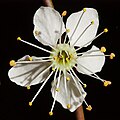bio.wikisort.org - Plant
Prunus cerasifera is a species of plum known by the common names cherry plum and myrobalan plum.[2] It is native to Southeast Europe[3][4][5] and Western Asia,[2][6] and is naturalised in the British Isles[3] and scattered locations in North America.[7][8][9] Also naturalized in parts of SE Australia where it is considered to be a mildly invasive weed of bushland near urban centers.
| Prunus cerasifera | |
|---|---|
 | |
Conservation status | |
 Data Deficient (IUCN 3.1) | |
| Scientific classification | |
| Kingdom: | Plantae |
| Clade: | Tracheophytes |
| Clade: | Angiosperms |
| Clade: | Eudicots |
| Clade: | Rosids |
| Order: | Rosales |
| Family: | Rosaceae |
| Genus: | Prunus |
| Subgenus: | Prunus subg. Prunus |
| Section: | Prunus sect. Prunus |
| Species: | P. cerasifera |
| Binomial name | |
| Prunus cerasifera Ehrh. 1784 not Popov 1929 nor Lecoq & Lamotte 1848 | |
| Synonyms[1] | |
|
List
| |
Description
Wild types are large shrubs or small trees reaching 8–12 m (25–40 feet) tall, sometimes spiny, with glabrous, ovate deciduous leaves 3–7 cm (1–3 in) long.[3]: 196 It is one of the first European trees to flower in spring,[3] often starting in mid-February before the leaves have opened. The flowers are white or pale pink and about 2 cm (3⁄4 in) across, with five petals and many stamens. The fruit is an edible drupe, 2–3 cm in diameter, ripening to yellow or red from early July to mid-September. They are self-fertile but can also be pollinated by other Prunus varieties such as the Victoria plum.[10] The plant propagates by seed or by suckering, and is often used as the rootstock for other Prunus species and cultivars.[3]
Cultivation
The cherry plum is a popular ornamental tree for garden and landscaping use, grown for its very early flowering. Numerous cultivars have been developed, many of them selected for purple foliage, such as P cerasifera var pissardii (Carrière) L.H. Bailey (P. 'Atropurpurea').[3][11] The cultivar 'Nigra' with black foliage and pink flowers, has gained the Royal Horticultural Society's Award of Garden Merit.[12] Prunus × cistena (purple leaf sand cherry), a hybrid of Prunus cerasifera and Prunus pumila, the sand cherry, also won the Award of Garden Merit.[13] [14][15] These purple-foliage forms (often called 'purple-leaf plum'), also have dark purple fruit, which make an attractive, intensely coloured jam. They can have white or pink flowers. The cultivar 'Thundercloud' has bright red foliage which darkens purple.[16] Others, such as 'Lindsayae', have green foliage. Some kinds of purple-leaf plums are used for bonsai[11] and other forms of living sculpture.
Cultivated cherry plums can have fruits, foliage, and flowers in any of several colours. Some varieties have sweet fruits that can be eaten fresh, while others are sour and better for making jam. Cherry plums are a key ingredient in Georgian cuisine where they are used to produce tkemali sauce, as well as a number of popular dishes, such as kharcho soup and chakapuli stew.
Gallery
- Flowers being pollinated
- Ripe fruit
- Flowers
- Prunus cerasifera bonsai (shohin size)
- close-up flower
See also
- List of plum dishes
Notes
- Prunus 'pissardii' and Prunus 'pissardii nigra' are cases of named cultivars sidling their way into being given binomial-style names
References
- "The Plant List: A Working List of All Plant Species". Retrieved 27 January 2014.
- UConn Horticulture Archived 14 April 2010 at the Wayback Machine
- Stace, C. A. (2010). New Flora of the British Isles (Third ed.). Cambridge, U.K.: Cambridge University Press. ISBN 9780521707725.
- Altervista Flora Italiana, Prunus cerasifera Ehrh. includes photos and European distribution map
- "UC/JEPS: Jepson Manual treatment for Prunus cerasifera". berkeley.edu.
- Flora of China, Prunus cerasifera Ehrhart, 1789. 樱桃李 ying tao li
- Flora of North America, Prunus cerasifera Ehrhart, 1784. Cherry plum, myrobalan
- "University of Washington Herbarium Image Collection - Burke Museum". washington.edu.
- "Calflora taxon report, University of California: Prunus cerasifera". calflora.org.
- Titmarsh, Alan (2008). The Kitchen Gardener. BBC Books. p. 247.
- Pissard Plum Fact Sheet
- "RHS Plant Selector Prunus cerasifera 'Nigra' AGM / RHS Gardening". Apps.rhs.org.uk. Retrieved 22 February 2020.
- "Prunus × cistena". RHS. Retrieved 18 February 2019.
- Plant Facts, Prunus x cistena - Purpleleaf Sand Cherry (Rosaceae)
- Nazareth College, Purpleleaf Sand Cherry Prunus x cistena Archived 2016-03-06 at the Wayback Machine/
- Thundercloud Fact Sheet
External links
- "Prunus cerasifera". Plants for a Future.
- "Prunus cerasifera divaricata". Plants for a Future.
- Prunus cerasifera in the CalPhotos photo database, University of California, Berkeley
- Prunus cerasifera - information, genetic conservation units and related resources. European Forest Genetic Resources Programme (EUFORGEN)
На других языках
- [en] Prunus cerasifera
[it] Prunus cerasifera
L'àmolo (Prunus cerasifera Ehrh., 1784), detto anche mirabolano, brombolo o marusticano, o semplicemente rusticano, è una pianta appartenente alla famiglia delle Rosaceae[1] e al genere Prunus. Il mirabolano è un albero da frutto ma spesso è anche usato come albero ornamentale.[ru] Алыча
Алыча́[2][3], или сли́ва растопы́ренная[2][4], или слива вишнено́сная[5] (лат. Prúnus cerasífera) — плодовое деревянистое растение; вид рода Слива подсемейства Сливовые семейства Розовые. Одна из исходных форм сливы домашней.Другой контент может иметь иную лицензию. Перед использованием материалов сайта WikiSort.org внимательно изучите правила лицензирования конкретных элементов наполнения сайта.
WikiSort.org - проект по пересортировке и дополнению контента Википедии





